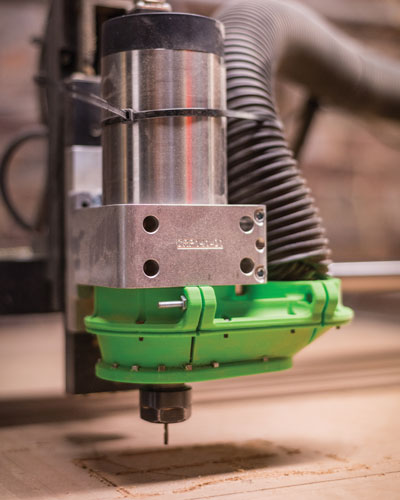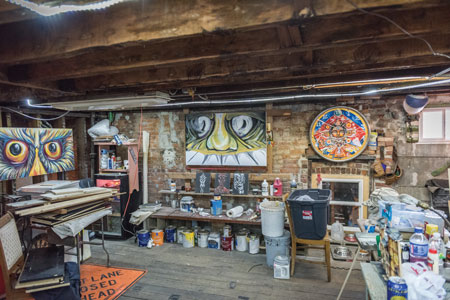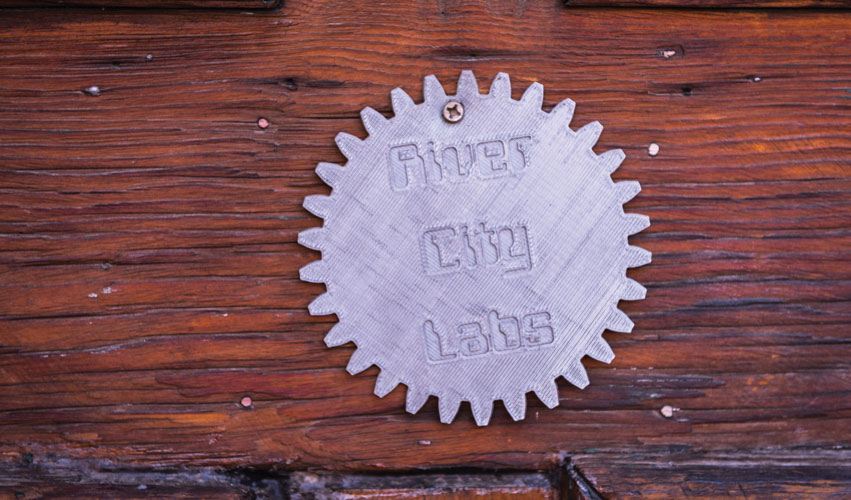Growing a 21st-century community of innovators, educators, leaders and learners…
Meet Joe Spanier: mechanical engineer by day, River City Labs president by night. And on this night, the lab is mostly quiet. Situated in Peoria’s Warehouse District, the space is inconspicuous enough that you might miss it if you didn’t know what to look for. The two-story building on Adams Street, owned by Colt Sandberg, houses a range of tools, projects at every stage of completion, and colorful, unique artwork.
River City Labs is a makerspace, a shared location where members can create together, learn from one another and come up with ideas. The first-floor space is new for the group—they started out upstairs and expanded to the ground level in December. The expansion allows them to carve out separate areas designated for different interests and capabilities. Tonight, one member is helping a couple of Bradley students work on a zoetrope, an early motion picture device. Off to the side, a gas-powered skateboard is in the works.
“Everybody comes to this space to share and learn something,” Spanier says. “Every week I’m intrigued to see what people are working on. I’m always blown away.”
 A Home for Innovation
A Home for Innovation
When it began, River City Labs was just a group of people who shared a passion for creation. “I was giving a presentation at Leaves N’ Beans in November 2013, and I met some others who wanted to start a makerspace,” he recalls. “We decided to meet up a few weeks later at thirty-thirty [Coffee Co.] and put together a plan for how we could all work together.”
For the next six months, members met in workshops and garages to work on their projects. Through all that, a community was born. And there was a need for it in central Illinois.
“If there wasn’t a need, this space would have died down a while ago,” Spanier says. “There are still people searching us out. The arts community here is hungry. And in Peoria, if you want to see it, you can start it.”
The group has since grown from a handful of members to more than four dozen now. It’s made up of engineers, teachers, students, retirees… basically anyone with an interest in creating. And on Thursday nights, the space is buzzing with the activity of 20 or more members and their various projects.
“Some members need a space to work, and some just come to be a part of the space and community,” he says. “It was cool to see those friendships form.”
Spanier is one of three of the seven founding members still involved. “It’s exciting to help a community like this grow—and to be on the forefront of it.”
Making Space for STEAM
“One of our directors, Jay Babin, says, ‘Innovation happens at the intersection of art and technology,’” Spanier says. “That’s where we exist. We have quirky art on the walls because we’re the people who live for engineering—and art comes out of that.”
One of the group’s goals, he adds, is to break down the barriers between art, technology and engineering. Instead of focusing only on the STEM (science, technology, engineering and math) disciplines, STEAM integrates art into the equation as well.

“There has been a large drop in trade programs and engineering,” Spanier notes. “Manufacturing and technology companies are struggling to fill those gaps.” Bringing art into the mix, he adds, is a natural fit, as these areas are all creatively intertwined.
“Art skills—including writing, drawing, photography and others—enhance the other disciplines. For example, one can run the best science experiments in the world, but without effective communication of the experiment, how good are they? From a different perspective, artists benefit from being exposed to the other disciplines, too. Imagine a sculptor who doesn’t know any engineering concepts, or a ceramics major who doesn’t know the material properties of clays and glazes.”
Makerspaces help fill a void left by the decline of high school “shop” class and other career/technical education programs—giving members a chance to learn practical skills from their passions. “I’m definitely not the only person who has gotten a job from the skills they’ve gained here,” Spanier adds.
The group also works with a University of Illinois Extension program called “Teacher Tuesdays” to further engage local educators on STEAM-related topics. The talks, hosted every other month on a Tuesday, began last December and have since been hosted at the Peoria PlayHouse Children’s Museum, Jump Simulation Center and Peoria Riverfront Museum.
“Teacher Tuesdays is an effort to help our region’s teachers understand the maker culture, and hopefully form a maker community amongst themselves,” explains Babin. “We have found that it is impossible for River City Labs to assist every teacher one-on-one, but it is possible to help all teachers by offering group social activities.”

Igniting a MakerFest
River City Labs has also paired with IGNITE Peoria, an annual celebration of creativity hosted by ArtsPartners of Central Illinois, to help bring STEAM to the larger community. “We got a booth that first year, and everyone banded together at the last minute to make it amazing,” Spanier says. “It ended up being popular enough that the next year, the organizers asked if we wanted to run our own section of IGNITE.”
It was dubbed the Midwest MakerFest, and the event was a hit. “The first year was a ton of fun,” Spanier says. “We had people coming from Iowa, Indiana and all over Illinois. We had tech talks, a drone obstacle course, first-person-view cars…. We learned a lot, including where our limits are.”
Those limits included manpower to run the event, and how much the group could ask of its volunteers. “Big ideas are fine and great,” he says, “but when it comes down to it, it’s very important to focus on realistic goals—and stretch after they are completed.”
The Midwest MakerFest has grown a lot since that first year, drawing more attendees and new demonstrations every year. Last year, the Central Illinois Bot Brawl joined in on the action. Hosted by the Central Illinois Robotics Club, the Bot Brawl featured more than 40 robots participating in a variety of “combat robotics” events and other competitions. It was so popular that it’ll be returning this year, along with an augmented reality sandbox, 3D printer creations and other features still in the works.
This kind of collaborative outreach is what helps keep STEAM alive in central Illinois, Spanier says, adding that “makerspaces are built on radical acts of sharing. And everyone has something to share in this space, even if they think they don’t.” a&s
River City Labs is a nonprofit community makerspace, funded exclusively by membership dues and donations. For more information, visit rivercitylabs.org or facebook.com/rclpeoria.


